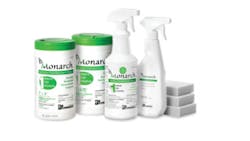Chairside Impact: Monarch Surface Disinfectant Wipes
Infection control (IC) is one of the most important elements dental practices use to protect patients and dental workers. The pandemic brought environmental IC and hand health into the spotlight. Patients are taking an active role in their health and noticing IC procedures and perceived cleanliness when they walk into your practice. The perception of your practice and skill often starts with their visual and sensory observations the minute they enter. IC recommendations and protocols have been evolving for many years and extend beyond the pandemic to protect patients and provide a safe working environment for dental workers.
Environmental IC practices are one piece of protecting yourself as a dental worker and are just as important as your personal protective equipment (PPE), hand health, and respiratory protection. IC protocols are sometimes a source of debate between dental team members when it comes to best practices.
More by Jamie Collins
Daily challenges: The drive for perfection can influence a dental hygienist’s quality of life
4 ways to reduce your risk of repetitive injuries
Differences of opinion may lead to a system that is not up to the Centers for Disease Control and Prevention (CDC) standards for dental offices.1 Individuals often assume all disinfectants have the same protocols and contact times to achieve disinfection success and safety, when in reality they vary in efficacy. Every office should appoint an IC compliance officer who is tasked with the responsibility to research and design protocols and make sure they’re maintained. Education and communication among team members ensures best IC practices are followed. Some offices bring in an IC consultant to ensure optimal performance.
Where to begin?
Any environmental IC protocol should start with removing organic debris and visibly soiled matter that may inhibit the effectiveness of the disinfecting solution. Preventing the transmission of potentially harmful pathogens is achievable when safety protocols are followed, and this includes allowing for the necessary chemical contact time. High-touch surfaces such as keyboards, handles, buttons, and switches should be covered with barriers when applicable and a surface disinfectant should be used when contaminated.
The CDC-accepted protocol option for surface disinfection includes either spray-wipe-spray or wipe-discard-wipe sequences to ensure removal of soiled matter and adequate disinfection of surfaces.1 Wipes approved for both cleaning and environment disinfection that provide a “one-step” disinfection on a visibly clean surface include Monarch by Air Techniques, among others.
A typical day in dentistry is busy with back-to-back patients, and a fast-acting surface disinfectant is key to keeping a smooth workflow and quick room turnover. A disinfection solution with fast contact time of one minute, such as Monarch surface wipes, rather than a 10-minute contact time solution, allows the office to maintain a streamlined flow and reduce the risk of contamination.
Refer to the manufacturer’s directions to ensure best practices and the correct contact time, and that the product is used for the desired disinfection areas without damaging equipment or surfaces. For example, choose a disinfectant that is effective against a broad spectrum of viruses, but be mindful and select a disinfectant with ingredients that will not damage or discolor equipment and chairs. You may use a chair and upholstery cleaner to maintain the integrity of the material but that does not provide disinfection properties. According to the CDC, any disinfectant you can purchase at the grocery store is not Environmental Protection Agency (EPA) registered or approved for use in a dental or medical setting.1
Know what you’re using
Not all surface disinfectants are created equal! Read the label to evaluate the ingredients and ensure a broad range of efficacy against tuberculosis, viruses, bacteria, and fungi. The ability to destroy tuberculosis is the key indicator in evaluating the ability, effectiveness, and contact time needed for a surface disinfectant.1 An ideal and effective EPA-registered disinfectant solution will kill enveloped viruses (coronavirus, hepatitis, HIV), large nonenveloped viruses (rotavirus), small nonenveloped viruses (norovirus, rhinovirus), mycobacterium (tuberculosis), pathogenic fungi, and encapsulated bacteria.
Disinfectant solutions vary in ingredients and often consist of a combination of active ingredients such as alcohol, quat (a quaternary ammonium compound widely used for disinfection), and/or hydrogen peroxide of varying levels. Dental workers are exposed to a variety of chemicals for patient care, and to maintain a clean and sterile environment, minimizing your risk for occupational exposure should be considered.
Infection prevention is sometimes overlooked when dental providers are stressed, overworked, or behind on the schedule. The importance of designing and maintaining a protocol that fits your practice and selecting a cleaning and disinfection combination solution or wipe that provides a one-minute contact time will accommodate the busy schedule when abiding by the manufacturer directions. Maintaining records and reporting will ensure all new hires are trained to the highest standards of infection prevention and will provide an annual review for all team members. Using personal safety protocols and environmental infection prevention will safeguard you, patients, and your practice.
Patient experience goes beyond what happens while seated in the dental chair. Using a fragrance-free disinfection solution as part of your IC protocol helps reduce fragrances many find unpleasant. Using the same disinfection solution or wipe that is also effective against odor-causing bacteria is a win-win for the practice. Gone are the days when every dental office had a strong chemical odor; today’s patient experience is as welcoming as walking into a store or spa.
Editor's note: This article appeared in the September 2022 print edition of RDH magazine. Dental hygienists in North America are eligible for a complimentary print subscription. Sign up here.
Reference
- Cleaning and disinfecting environmental surfaces. Centers for Disease Control and Prevention. Last reviewed March 25, 2016. https://www.cdc.gov/oralhealth/infectioncontrol/faqs/cleaning-disinfecting-environmental-surfaces.html
About the Author

Jamie Collins, BS, RDH-EA
Jamie Collins, BS, RDH-EA, is licensed in Idaho and Washington states and dedicated to advancing the dental profession. More than 20 years in the dental field has led her to becoming involved in many aspects of patient care. With a passion for patients with high risk factors, Collins enjoys sharing the tips and tricks of the dental profession through speaking and writing, with over 80 articles published worldwide. Collins has also contributed to multiple textbooks, curriculum development, and as a key opinion leader for various companies. She was named the Professional Education Manager at MouthWatch. Contact her at [email protected] or visit mydentaleducator.com.
Updated August 8, 2022
